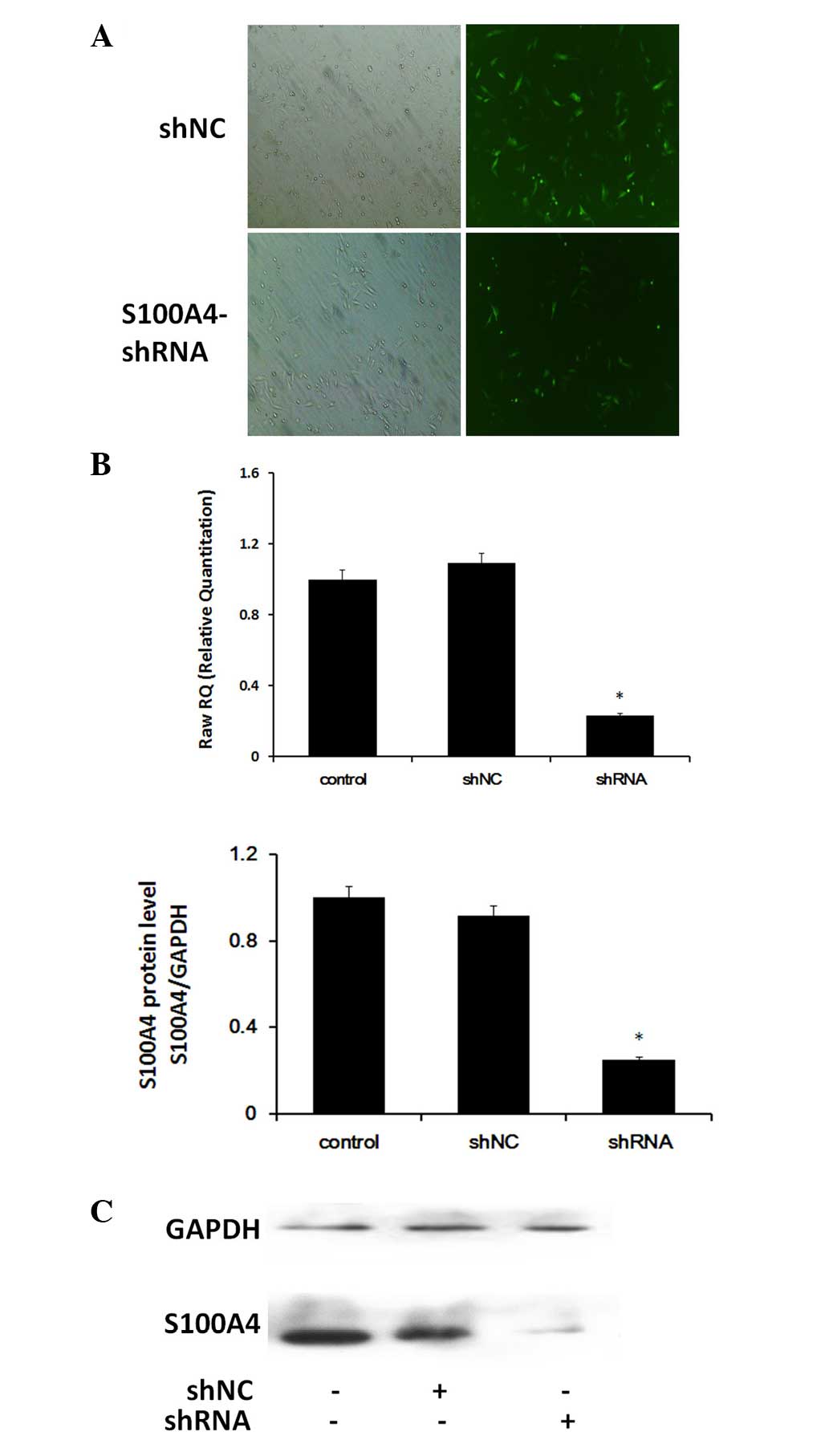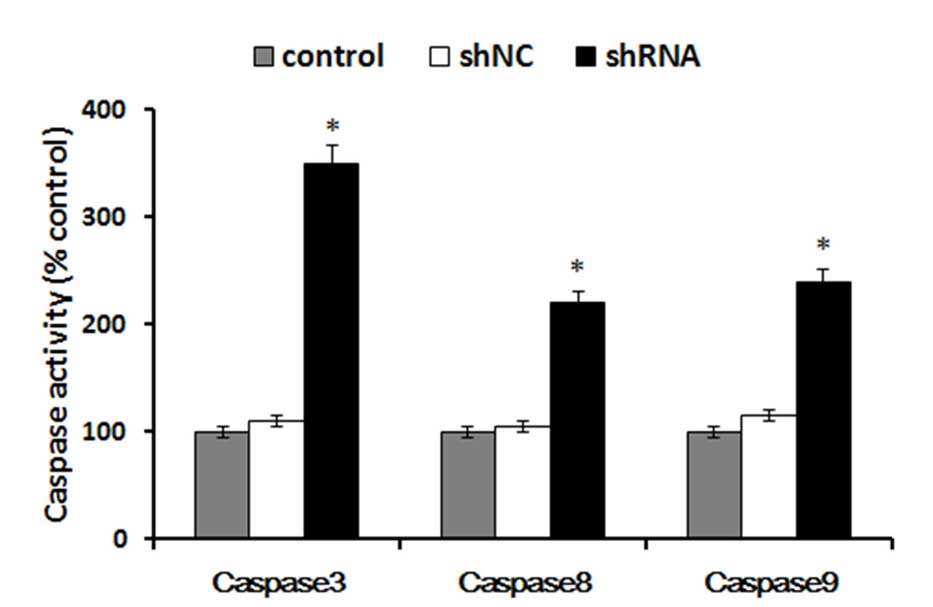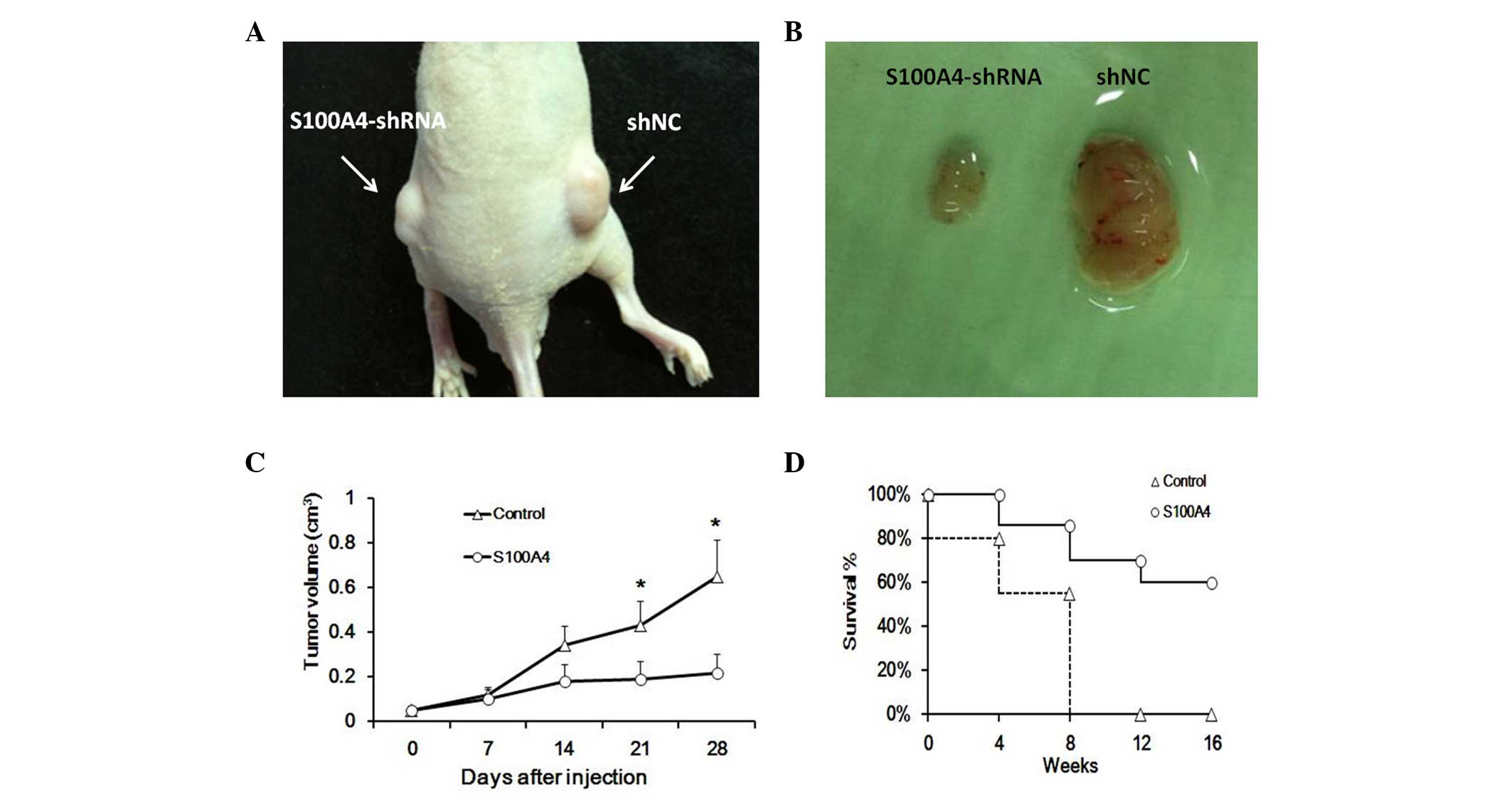|
1
|
Ragin CC, Modugno F and Gollin SM: The
epidemiology and risk factors of head and neck cancer: a focus on
human papillomavirus. J Dent Res. 86:104–114. 2007. View Article : Google Scholar : PubMed/NCBI
|
|
2
|
Jemal A, Siegel R, Ward E, Murray T, Xu J
and Thun MJ: Cancer statistics, 2007. CA Cancer J Clin. 57:43–66.
2007. View Article : Google Scholar
|
|
3
|
Marioni G, Marchese-Ragona R, Cartei G,
Marchese F and Staffieri A: Current opinion in diagnosis and
treatment of laryngeal carcinoma. Cancer Treat Rev. 32:504–515.
2006. View Article : Google Scholar : PubMed/NCBI
|
|
4
|
Mahon PC, Baril P, Bhakta V, et al: S100A4
contributes to the suppression of BNIP3 expression,
chemoresistance, and inhibition of apoptosis in pancreatic cancer.
Cancer Res. 67:6786–6795. 2007. View Article : Google Scholar : PubMed/NCBI
|
|
5
|
Pedersen MV, Køhler LB, Grigorian M, et
al: The Mts1/S100A4 protein is a neuroprotectant. J Neurosci Res.
77:777–786. 2004. View Article : Google Scholar : PubMed/NCBI
|
|
6
|
Sekine H, Chen N, Sato K, et al: S100A4,
frequently overexpressed in various human cancers, accelerates cell
motility in pancreatic cancer cells. Biochem Biophys Res Commun.
429:214–219. 2012. View Article : Google Scholar : PubMed/NCBI
|
|
7
|
Boye K, Nesland JM, Sandstad B, Haugland
Haugen M, Mælandsmo GM and Flatmark K: EMMPRIN is associated with
S100A4 and predicts patient outcome in colorectal cancer. Br J
Cancer. 107:667–674. 2012. View Article : Google Scholar : PubMed/NCBI
|
|
8
|
Li H, Liu Z, Xu C, et al: Overexpression
of S100A4 is closely associated with the progression and prognosis
of gastric cancer in young patients. Oncol Lett. 5:1485–1490.
2013.PubMed/NCBI
|
|
9
|
Klingelhöfer J, Grum-Schwensen B, Beck MK,
et al: Anti-S100A4 antibody suppresses metastasis formation by
blocking stroma cell invasion. Neoplasia. 14:1260–1268.
2012.PubMed/NCBI
|
|
10
|
Wang Z and Griffin M: The role of TG2 in
regulating S100A4-mediated mammary tumour cell migration. PLoS One.
8:e570172013. View Article : Google Scholar : PubMed/NCBI
|
|
11
|
Liu J, Guo Y, Fu S, Yang M, Sun KL and Fu
WN: Hypomethylation-induced expression of S100A4 increases the
invasiveness of laryngeal squamous cell carcinoma. Oncol Rep.
23:1101–1107. 2010.PubMed/NCBI
|
|
12
|
Toolan HW: Transplantable human neoplasms
maintained in cortisone-treated laboratory animals: H.S. No. 1; HEp
No. 1; HEp No. 2; HEp No. 3; and HEmbRh No. 1. Cancer Res.
14:660–666. 1954.PubMed/NCBI
|
|
13
|
Boehm D, Herold S, Kuechler A, Liehr T and
Laccone F: Rapid detection of subtelomeric deletion/duplication by
novel real-time quantitative PCR using SYBR-green dye. Hum Mutat.
23:368–378. 2004. View Article : Google Scholar : PubMed/NCBI
|
|
14
|
Zhao Y, Zhang T and Wang Q: S100
calcium-binding protein A4 is a novel independent prognostic factor
for the poor prognosis of gastric carcinomas. Oncol Rep.
30:111–118. 2013.
|
|
15
|
Roh J, Knight S, Chung JY, et al: S100A4
expression is a prognostic indicator in small intestine
adenocarcinoma. J Clin Pathol. 67:216–221. 2014. View Article : Google Scholar : PubMed/NCBI
|
|
16
|
Berge G, Pettersen S, Grotterød I, Bettum
IJ, Boye K and Mælandsmo GM: Osteopontin - an important downstream
effector of S100A4-mediated invasion and metastasis. Int J Cancer.
129:780–790. 2011. View Article : Google Scholar : PubMed/NCBI
|
|
17
|
Sack U, Walther W, Scudiero D, et al:
S100A4-induced cell motility and metastasis is restricted by the
Wnt/beta-catenin pathway inhibitor calcimycin in colon cancer
cells. Mol Biol Cell. 22:3344–3354. 2011. View Article : Google Scholar : PubMed/NCBI
|
|
18
|
Chen X, Luther G, Zhang W, et al: The E-F
hand calcium-binding protein S100A4 regulates the proliferation,
survival and differentiation potential of human osteosarcoma cells.
Cell Physiol Biochem. 32:1083–1096. 2013. View Article : Google Scholar : PubMed/NCBI
|
|
19
|
Yang XC, Wang X, Luo L, et al: RNA
interference suppression of A100A4 reduces the growth and
metastatic phenotype of human renal cancer cells via
NF-kB-dependent MMP-2 and bcl-2 pathway. Eur Rev Med Pharmacol Sci.
17:1669–1680. 2013.PubMed/NCBI
|
|
20
|
Tabata T, Tsukamoto N, Fooladi AA, et al:
RNA interference targeting against S100A4 suppresses cell growth
and motility and induces apoptosis in human pancreatic cancer
cells. Biochem Biophys Res Commun. 390:475–480. 2009. View Article : Google Scholar : PubMed/NCBI
|
|
21
|
Hua J, Chen D, Fu H, et al: Short hairpin
RNA-mediated inhibition of S100A4 promotes apoptosis and suppresses
proliferation of BGC823 gastric cancer cells in vitro and in vivo.
Cancer Lett. 292:41–47. 2010. View Article : Google Scholar : PubMed/NCBI
|
|
22
|
Maelandsmo GM, Hovig E, Skrede M, et al:
Reversal of the in vivo metastatic phenotype of human tumor cells
by an anti-CAPL (mts1) ribozyme. Cancer Res. 56:5490–5498.
1996.PubMed/NCBI
|
|
23
|
Pedersen KB, Andersen K, Fodstad Ø and
Maelandsmo GM: Sensitization of interferon-gamma induced apoptosis
in human osteosarcoma cells by extracellular S100A4. BMC Cancer.
4:522004. View Article : Google Scholar : PubMed/NCBI
|
|
24
|
Grigorian M, Andresen S, Tulchinsky E, et
al: Tumor suppressor p53 protein is a new target for the
metastasis-associated Mts1/S100A4 protein: functional consequences
of their interaction. J Biol Chem. 276:22699–22708. 2001.
View Article : Google Scholar
|
|
25
|
Orre LM, Panizza E, Kaminskyy VO, et al:
S100A4 interacts with p53 in the nucleus and promotes p53
degradation. Oncogene. 32:5531–5540. 2013. View Article : Google Scholar : PubMed/NCBI
|
|
26
|
Cho SG and Choi EJ: Apoptotic signaling
pathways: caspases and stress-activated protein kinases. J Biochem
Mol Biol. 35:24–27. 2002. View Article : Google Scholar : PubMed/NCBI
|
|
27
|
Fan TJ, Han LH, Cong RS and Liang J:
Caspase family proteases and apoptosis. Acta Biochim Biophys Sin
(Shanghai). 37:719–727. 2005. View Article : Google Scholar : PubMed/NCBI
|
|
28
|
Slee EA, Harte MT, Kluck RM, et al:
Ordering the cytochrome c-initiated caspase cascade: hierarchical
activation of caspases-2, -3, -6, -7, -8, and -10 in a
caspase-9-dependent manner. J Cell Biol. 144:281–292. 1999.
View Article : Google Scholar : PubMed/NCBI
|
|
29
|
Shi Y, Zou M, Collison K, et al:
Ribonucleic acid interference targeting S100A4 (Mts1) suppresses
tumor growth and metastasis of anaplastic thyroid carcinoma in a
mouse model. J Clin Endocrinol Metab. 91:2373–2379. 2006.
View Article : Google Scholar : PubMed/NCBI
|
|
30
|
Lo JF, Yu CC, Chiou SH, et al: The
epithelial-mesenchymal transition mediator S100A4 maintains
cancer-initiating cells in head and neck cancers. Cancer Res.
71:1912–1923. 2011. View Article : Google Scholar : PubMed/NCBI
|














